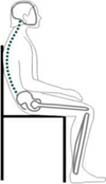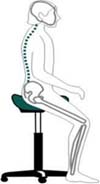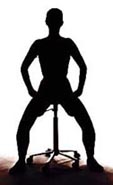Good posture without a backrest
In a saddle seat your spine stays aligned naturally without a backrest. This occurs for two reasons: First, the open thigh-to-torso angle naturally aligns the spine, and second, the wide spread of the knees (called hip abduction) automatically holds your pelvis upright.
Saddle seats are available with backrests, but unless you sit in a fixed posture for very long periods of time (e.g., micro-surgeon, microscope user, etc.), or you are very weak with poor muscle control, you will probably prefer to ride your saddle without a backrest.

In a conventional chair your hip angle approaches 90°. This rotates your pelvis backward and slumps your back. |

In a saddle seat your hip angle is open, about 45° from the horizontal. This naturally produces good posture. |
Your core muscles support you in a saddle seat. Not so in conventional seating.
When you saddle-sit your postural muscles are active, including your trunk, pelvis and leg muscles. In a conventional chair, your postural and leg muscles are dormant most of the time.
If your postural muscles are asleep when you sit, you will be dependent on arm support and back rests for support. If your postural muscles are active when you sit, you can be free of armrests and backrests.

Your feet are ideally positioned beneath your body's center-of-mass in a saddle.
In a conventional chair, your feet are positioned forward of your body where they cannot provide support. With your feet underneath you providing support, you'll feel less need for armrests and you'll be able to move your arms more freely and with greater control. Plus, you'll be able to scoot around your work space more easily.
Hip abduction stabilizes your pelvis upright.
The wide spread of your legs, called "hip abduction", stabilizes your pelvis in an upright orientation. This effortlessly supports your spine in perfect posture without additional support. In a conventional ergonomic chair your knees are closer together, which causes your pelvis to slump and roll backward.
The wider the hip abduction (leg spread) the better your posture will be. The closer-together your knees, the greater your tendency to slump.
Try it now! Sit with your knees together and see how far you can slump. Now sit with your knees apart and try to slump again. Feel the difference?

A backrest can make a saddle seat uncomfortable.
In a saddle-sitting active posture, your torso center-of-mass (COM) is forward of your sit bones (ischial tuberosities). Back supports provide no support when your COM is forward of your sit bones. Back supports are effective only if/when your COM is posterior to your sit bones. Some degree of torso recline is required in order to transfer body weight to a backrest. It’s simple physics.
Some recline of the pelvis is necessary in order to use a backrest. By design, the saddle shape does not accommodate a reclined pelvis, otherwise you would slump in the seat. If you use a backrest with a saddle seat, the saddle may become uncomfortable because it is not shaped to support a reclined pelvic orientation. Therefore, when a backrest is used with a saddle seat, it is generally used only briefly as an intermittent rest or to stabilize the body for fine hand-eye tasks. Backrests are also useful as a safety for people with weakness, balance disorders, uncontrolled movements, or similar clinical conditions.
Article reproduced with permission from ergoTALK ©2008-2015.